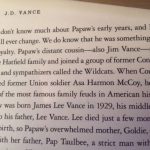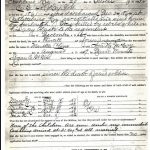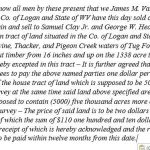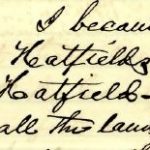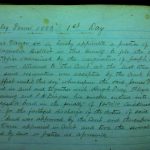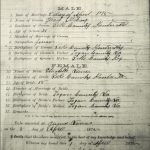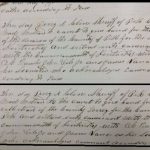During my first week in graduate school at Cornell back in the 1960’s, a fellow grad student from Brooklyn asked me: “What kind of people kill a hundred of each other over a pig?” As the son of a Pike County, Kentucky coal miner who was killed in the mine when I was seven years old, I had enough weight to carry without the extra load of lies such as the commercialized Hatfield and McCoy feud tale. Hillbilly Elegy is just another brick in the load. “Elegy” tells the public nothing at all about what it was really like to grow up in Appalachia. Nothing!
While it is difficult to sell enough REAL Appalachian history books to recoup the cost of publishing them, a man can still make millions slandering my people. I knew before I started reading the book that it would be another big put down of my people, because it was being pushed so hard by all who enjoy having hillbillies to look down upon.
In the first 50 pages, I saw the four-letter “F-word,” more times than I heard or saw it in 18 years of growing up on Blackberry Creek, in Pike County, Kentucky, the very heart of Appalachia. Almost all of the dozens of usages of that word are ascribed to his grandmother, who was born several years before I was born. A hillbilly woman of my generation or older frequently emitting that expletive is about as credible as a Brooklyn Jewish grandmother sitting on the front porch smoking a corn cob pipe. We will deal with that in the next post, but first we will examine Vance’s knowledge of hillbilly history, particularly the history of the Vance family.
There ought to be a law stating that anyone who writes a book about his family, and connects them to the Hatfields and McCoys, must be historically correct or go to jail! The attached screenshot is a paragraph on Jim Vance, who is claimed to be a distant relative of the author. It is FALSE in detail!
(Click thumbnails to view)
James M. Vance, called a murderer by his ‘kinsman’, J.D., Vance, was a leading member of his community, on both sides of Tug River. In a lifetime of almost sixty years, he was never charged with a crime–not even a misdemeanor. He was elected constable and later appointed justice of the peace in Logan County, West Virginia. He signed the sheriff’s bond for Perry Cline, brother-in-law of Asa Harmon McCoy in Pike County, Kentucky, and was the first man appointed as a deputy by the sheriff. Does anyone really believe that Perry Cline thought Jim Vance murdered his sister’s husband? Had that been so, Cline would have tossed Jim into the Pike hoosegow, but he appointed him a deputy.
Jim Vance did not “marry into the Hatfield family.” Jim’s wife was Mary Collins, no relation to the Hatfield. Jim’s sister, Nancy, married Ephraim Hatfield in Logan County, WV, and they produced Anderson, now called “Devil Anse.” Another sister, Mary, married Valentine Hatfield in Pike County, Kentucky. They are my gg-grandparents.
Jim Vance never “Joined a group of former Confederate soldiers and sympathizers called the Wildcats.” The Wildcats referred to here were the Logan Wildcats, a Logan militia unit, which became Company D of the 36th Virginia Infantry. The Wildcats were taken into the regular Confederate army soon after Fort Sumter, and remained part of the regular army until Appomattox. The Wildcats never operated within a day’s ride of where Harmon McCoy was killed, and neither James Vance nor Anse Hatfield were ever members of that company.
Martha McCoy, widow of Asa Harmon McCoy, gave us the facts in this affidavit, wherein she says that he was killed by Rebels, while on his way back to his regiment. Note that her first witness was Basil HATFIELD.
Jim Vance, a leading member of his community, owning several thousand acres of valuable land, smack-dab in the heart of the “Billion Dollar Coal Field,” was murdered by a gang from Kentucky on January 8, 1888. That gang was sent by some of the leading financial men in Kentucky, for the purpose of kidnapping the men who were indicted for the lynching of the three McCoys five years earlier. There were 23 men under indictment, and the Kentucky gang nabbed 9 of them. Of course those nine just happened to all be owners of land along the route of the coming railroad. Within 90 days of the killing of Jim Vance, Kentucky financiers would own all the land of the indicted West Virginians, with the exception of Devil Anse Hatfield. Old Devil Anse pulled a fast one, selling his land to a Logan land dealer, who flipped it to the Torpin Group of Philadelphia., thus depriving the Kentucky cabal of 5,000 acres of prime coal land.
The Kentucky cabal had no such legal hook with which to catch Jim Vance, so they simply murdered him. Three weeks later the New York newspaperman, John Spears, visited Pikeville, and the men who murdered Jim Vance told him a tale. That tale was published in papers all over the country, and is now accepted as history. But it is all a lie, and the records prove it.
On day short of four months after Jim Vance was murdered, the Kentuckians got what they wanted, as Jim Jr. and his brother-in-law sold George Headley and Samuel Clay 5,000 acres for a pittance. And they didn’t even have to pay cash! George Headley was a leading Bluegrass horse breeder, and founder of Keeneland Race Course. Samuel Clay, cousin to the great Senator, Henry Clay, was president of Kentucky’s largest distillery and a director of a railroad. Here is my transcription of that deed:
Here is a snip from a letter to the governor from Sam Clay, written in April, 1888, wherein he says that he knows all the Hatfields and has bought all the land from most of them.
J.D. Vance could have written a much more engrossing story if he had only taken the time to research his own ancestors. Vance conjured up a paragraph, not a bit of which is true, and tried to connect it with real history. If he had taken the time to do real research, he would have found the documentation that gives us REAL history. Some of those documents are shown below.
This is from the June, 1883 report of the Logan County Court. The justice of the Magnolia District resigned and the court voted to name James Vance as justice of the peace. Note that four landowners signed bonds of $2,500, the equivalent of about $150,000 today, guaranteeing the faithful performance in office of a man J.D. Vance says was wanted for murder.
This one shows that the daughter of Jim Vance married the son of Asa Harmon McCoy in 1875, ten years after J.D Vance says that Jim murdered Jacob McCoy’s father. As the certificate shows, the nuptials were solemnized at the home of Jim Vance.
In Kentucky, every county officer has to have a bond to protect the public from malfeasance. That is especially important for the office of sheriff, as that official is responsible for collecting all the county’s taxes. If a sheriff absconded with the public’s funds, the signatories of that bond were liable for the entire amount. When Perry Cline, whose sister was the widow of Asa H. McCoy, was elected sheriff, his bondsmen were Colonel John Dils and O.C. Bowles two of the three richest men in Pike County, along with his friend, James Vance.
Surely by now you don’t believe that Perry Cline thought Jim Vance murdered his brother-in-law, no matter what an Ohioan masquerading as a hillbilly says.
